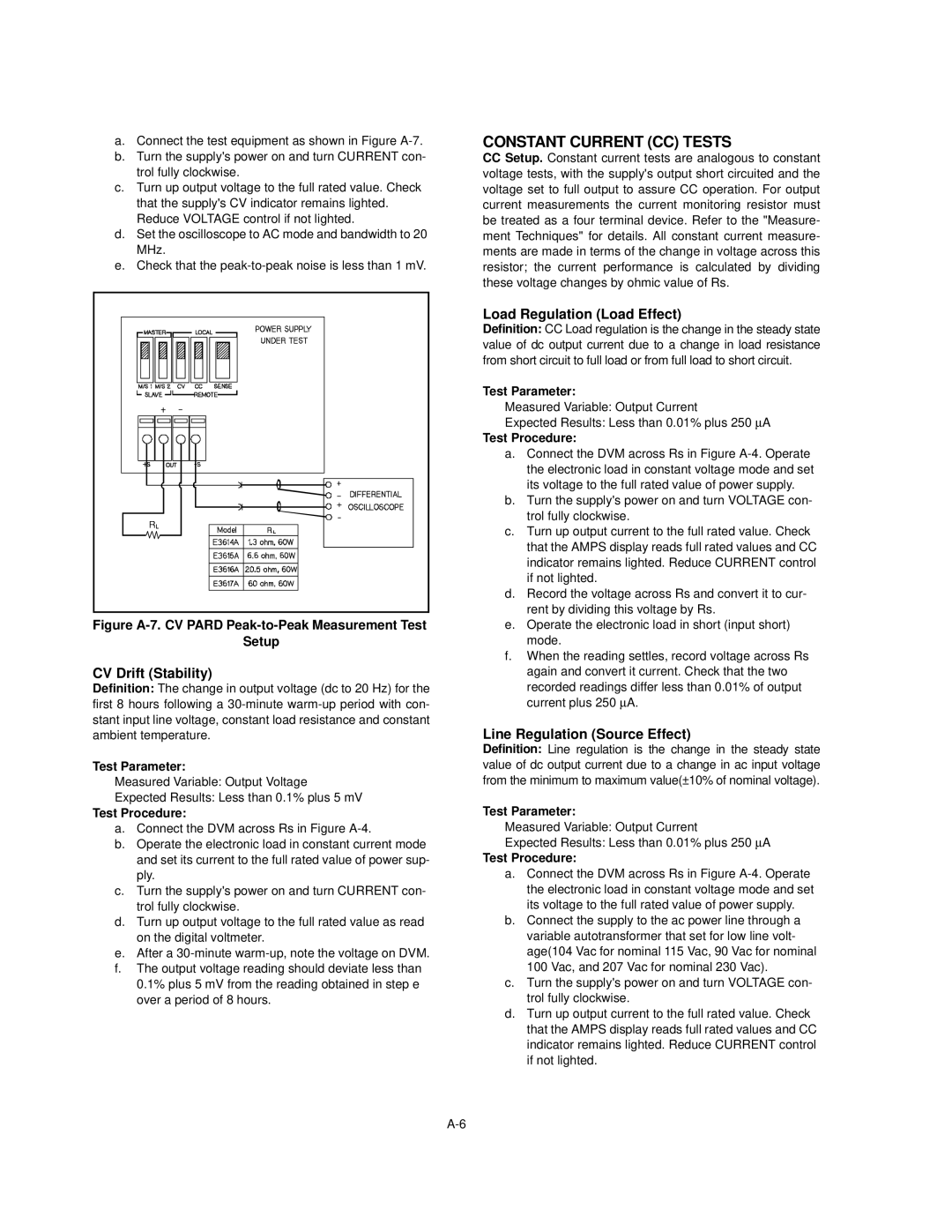
a.Connect the test equipment as shown in Figure
b.Turn the supply's power on and turn CURRENT con- trol fully clockwise.
c.Turn up output voltage to the full rated value. Check that the supply's CV indicator remains lighted. Reduce VOLTAGE control if not lighted.
d.Set the oscilloscope to AC mode and bandwidth to 20 MHz.
e.Check that the
Figure A-7. CV PARD Peak-to-Peak Measurement Test
Setup
CV Drift (Stability)
Definition: The change in output voltage (dc to 20 Hz) for the first 8 hours following a
Test Parameter:
Measured Variable: Output Voltage
Expected Results: Less than 0.1% plus 5 mV
Test Procedure:
a.Connect the DVM across Rs in Figure
b.Operate the electronic load in constant current mode and set its current to the full rated value of power sup- ply.
c.Turn the supply's power on and turn CURRENT con- trol fully clockwise.
d.Turn up output voltage to the full rated value as read on the digital voltmeter.
e.After a
f.The output voltage reading should deviate less than 0.1% plus 5 mV from the reading obtained in step e over a period of 8 hours.
CONSTANT CURRENT (CC) TESTS
CCSetup. Constant current tests are analogous to constant voltage tests, with the supply's output short circuited and the voltage set to full output to assure CC operation. For output current measurements the current monitoring resistor must be treated as a four terminal device. Refer to the "Measure- ment Techniques" for details. All constant current measure- ments are made in terms of the change in voltage across this resistor; the current performance is calculated by dividing these voltage changes by ohmic value of Rs.
Load Regulation (Load Effect)
Definition: CC Load regulation is the change in the steady state value of dc output current due to a change in load resistance from short circuit to full load or from full load to short circuit.
Test Parameter:
Measured Variable: Output Current
Expected Results: Less than 0.01% plus 250 μA
Test Procedure:
a.Connect the DVM across Rs in Figure
b.Turn the supply's power on and turn VOLTAGE con- trol fully clockwise.
c.Turn up output current to the full rated value. Check that the AMPS display reads full rated values and CC indicator remains lighted. Reduce CURRENT control if not lighted.
d.Record the voltage across Rs and convert it to cur- rent by dividing this voltage by Rs.
e.Operate the electronic load in short (input short) mode.
f.When the reading settles, record voltage across Rs again and convert it current. Check that the two
recorded readings differ less than 0.01% of output current plus 250 μA.
Line Regulation (Source Effect)
Definition: Line regulation is the change in the steady state value of dc output current due to a change in ac input voltage from the minimum to maximum value(±10% of nominal voltage).
Test Parameter:
Measured Variable: Output Current
Expected Results: Less than 0.01% plus 250 μA
Test Procedure:
a.Connect the DVM across Rs in Figure
b.Connect the supply to the ac power line through a variable autotransformer that set for low line volt- age(104 Vac for nominal 115 Vac, 90 Vac for nominal 100 Vac, and 207 Vac for nominal 230 Vac).
c.Turn the supply's power on and turn VOLTAGE con- trol fully clockwise.
d.Turn up output current to the full rated value. Check that the AMPS display reads full rated values and CC indicator remains lighted. Reduce CURRENT control if not lighted.
